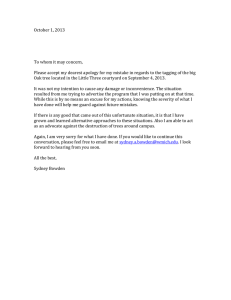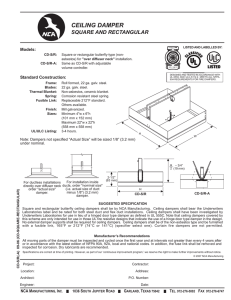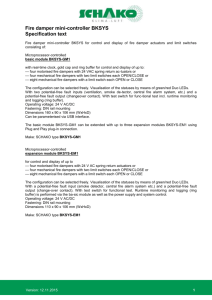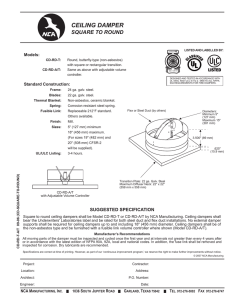Practical Solutions To Everyday Problems!
advertisement
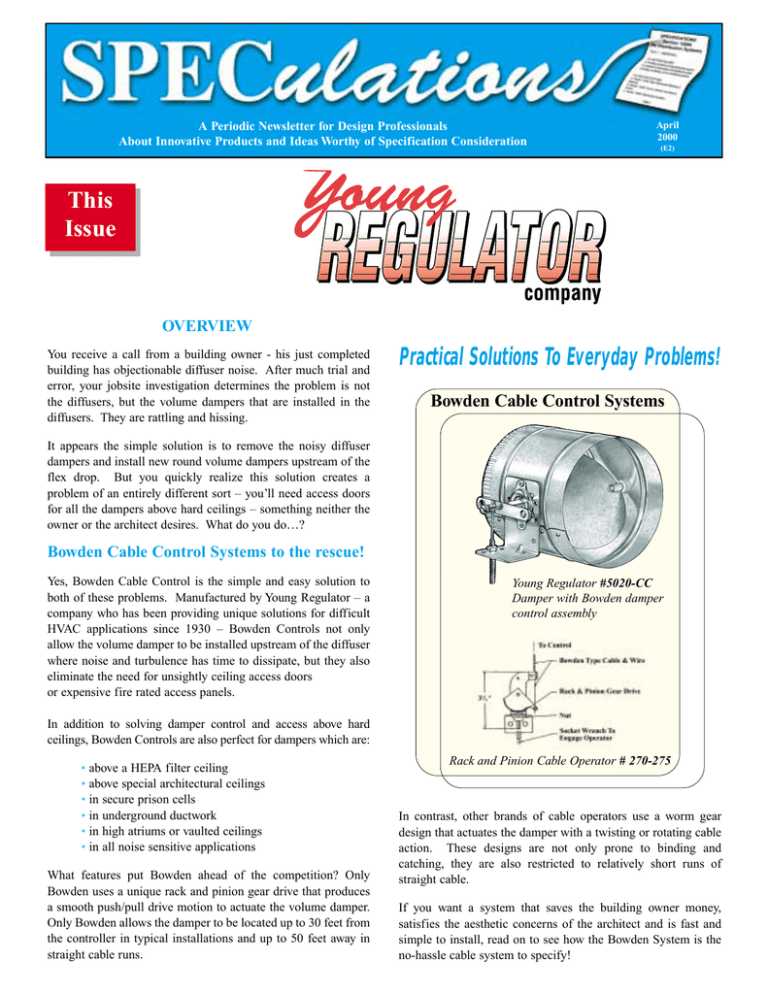
A Periodic Newsletter for Design Professionals About Innovative Products and Ideas Worthy of Specification Consideration April 2000 (E2) This Issue OVERVIEW You receive a call from a building owner - his just completed building has objectionable diffuser noise. After much trial and error, your jobsite investigation determines the problem is not the diffusers, but the volume dampers that are installed in the diffusers. They are rattling and hissing. Practical Solutions To Everyday Problems! Bowden Cable Control Systems It appears the simple solution is to remove the noisy diffuser dampers and install new round volume dampers upstream of the flex drop. But you quickly realize this solution creates a problem of an entirely different sort – you’ll need access doors for all the dampers above hard ceilings – something neither the owner or the architect desires. What do you do…? Bowden Cable Control Systems to the rescue! Yes, Bowden Cable Control is the simple and easy solution to both of these problems. Manufactured by Young Regulator – a company who has been providing unique solutions for difficult HVAC applications since 1930 – Bowden Controls not only allow the volume damper to be installed upstream of the diffuser where noise and turbulence has time to dissipate, but they also eliminate the need for unsightly ceiling access doors or expensive fire rated access panels. Young Regulator #5020-CC Damper with Bowden damper control assembly In addition to solving damper control and access above hard ceilings, Bowden Controls are also perfect for dampers which are: • above a HEPA filter ceiling • above special architectural ceilings • in secure prison cells • in underground ductwork • in high atriums or vaulted ceilings • in all noise sensitive applications What features put Bowden ahead of the competition? Only Bowden uses a unique rack and pinion gear drive that produces a smooth push/pull drive motion to actuate the volume damper. Only Bowden allows the damper to be located up to 30 feet from the controller in typical installations and up to 50 feet away in straight cable runs. Rack and Pinion Cable Operator # 270-275 In contrast, other brands of cable operators use a worm gear design that actuates the damper with a twisting or rotating cable action. These designs are not only prone to binding and catching, they are also restricted to relatively short runs of straight cable. If you want a system that saves the building owner money, satisfies the aesthetic concerns of the architect and is fast and simple to install, read on to see how the Bowden System is the no-hassle cable system to specify! Bowden Cable Control BENEFITS TO THE ENGINEER Quiet – Bowden systems allow the noise generating damper to be installed in the duct away from the ceiling outlet, greatly reducing room noise. Adaptable – Available with five control mounting options, Bowden controls work equally well with retrofits and existing dampers for design flexibility. Versatile – Bowden cable controls are available for round or rectangular dampers, as well as in kit form to fit other manufacturers’ dampers. They also give technicians the ability to control dampers in difficult to reach areas, such as dampers encased in concrete. Inconspicuous – The ceiling regulator can be mounted anywhere you want it, up to 50 straight feet from the damper. Unlike worm or miter gear systems, the Bowden controls are not required to be mounted directly below the damper. #830A-CC Rectangular Damper “The Best Way to Remotely Control a Balancing Damper”. BENEFITS TO THE OWNER/CONTRACTOR Locking Controller – The rack and pinion controller securely holds the damper in position for precise dependable settings. Efficiency – When the damper is remote from the diffuser, the air turbulence it generates has time to dissipate, allowing the diffuser to perform optimally. Quick Installation – The Bowden cable system is quick and easy to install. Its uncomplicated design substantially reduces installation costs. Noise Reduction – Bowden allows dampers to be installed up to 30 feet from the diffuser (50 feet is possible with no turns). This greatly reduces noise from the damper traveling to the diffuser. Simplicity – No complicated linkage from damper to ceiling regulator. The flexible cable and wire can be routed around electrical conduit, piping and other obstructions, without fear of binding or catching. Control Mounting Options 3 3/8” Plastic Cap 3 3/8” Pipe Support “U” Bracket 2 1/4” Steel Pipe 3” Dia. Cap #270-301 Bowden control kit 7/8” Dia. Cap No Access Doors – Bowden cable systems eliminate the need to require unsightly access door panels in the ceiling. The inconspicuous controls can be hidden in remote locations or even in concealed linear diffuser plenums. Ceiling #270-896C Bowden control kit Centrally Locatable – Bowden allows for routing multiple damper controls to one location for convenient centralized balancing. Easy Balancing – Bowden Control’s unique design means balancing time is reduced by two thirds. This translates to significant savings for the owner. Support Bracket SPECIFICATION TIP! ✎ Contractors often miss Bowden specifications at bid time. To make sure you get what you specify without a fight down the road, give any air distribution device that requires Bowden Controls a separate tag number on your equipment schedule. Note in the remarks column for these tags: “Bowden remote cable control and damper required.” What Do Contractors Say about Bowden? “We installed the Bowden Cable System in a casino and were very impressed with the aesthetics and ease of installation. It took less than a quarter of the time to install compared to worm/miter gear systems.” Mike Osburn, Site Foreman, University Mechanical “Bowden Cable Control systems can be balanced in half the time of manual volume dampers and with only one person instead of two. Bowden can pay for itself on the first balancing!” James Rosier, Vice President, Equal Air Balance, N.E.B.B. member Another Solution From Young Regulator... Another perSPECtive... Opposed Blade Volume Dampers For Smaller Ducts Reduce Noise and Turbulence By Dave McIntyre The question, “How do you set and balance airflow through a diffuser in a hard ceiling?” is most often answered, “with an opposed blade damper in the diffuser neck”. However, for many noise sensitive applications, that answer could lead to unexpected job site problems. It’s little known fact of diffuser performance ratings that all noise levels published are based on devices tested without dampers or other restrictive accessories. It’s only in the footnotes or engineering guidelines of a catalog where you learn that dampers are significant noise generators, commonly adding anywhere from 5 to 15 NC per diffuser outlet. With acoustically sensitive hard ceiling applications, multiple dampered diffusers can result in room noise levels as much as 20 NC higher than predicted from cataloged diffuser ratings. If not anticipated, this can be a most unpleasant field discovery. If you’ve experienced this problem, then you may have already adjusted your specifications to preclude the use of any dampering device at an air outlet. The common alternative is to specify manual balancing dampers eight feet or more upstream of the diffusers. This works fine in lay-in ceilings, but for hard ceilings, the only way to access these balancing dampers is through multiple access doors or ceiling panels. The catch is: These access doors are rarely acceptable to the architect or building owner. When your project needs volume dampers above inaccessible ceilings, the best “answer” is to specify effective and inexpensive Bowden Cable Controls by Young Regulator - the simple solution to damper noise and access problems! Because opposed blade dampers distribute air more evenly, reducing both turbulence and noise, their advantages over parallel or single blade dampers are well recognized. For these reasons, most designers insist on opposed blade dampers for their HVAC duct designs. In addition, when the air passes through the narrow opening between the damper blade and the duct, high frequency noise is generated. A significant amount of radiated noise is also produced by the jet of air from a single blade damper against the flat drum-like bottom surface of the duct. However, in smaller ducts, unless you specify otherwise, a single blade balancing or volume damper is almost always installed. When a single blade damper is 100% open, it typically is not a problem. The problems arise as you begin to close the damper blade to reduce air volume. As the single blade closes, the surface area is increased significantly against the airflow. This causes the airflow to be much more turbulent, adding pressure drop and undesired system effect. Solution: Young Regulator series 820 (manual) or 830 (Bowden controlled) opposed blade volume dampers specifically designed for small ducts. These cost effective dampers feature strong extruded aluminum blades on 2" centers with individual Teflon bushings on every blade for dependable, rattle-free operation. Available with horizontal or vertical blades, these high free area dampers provide smooth and accurate volume control in duct sizes as small as 2" in height! EVEN AIR FLOW QUIET Manual Rectangular Damper #820A-L Young Regulator’s opposed blade dampers (above allow air to be evenly distributed over the blades while reducing turbulence and noise. A single blade damper (below) reduces air control while increasing turbulence and air stream noise. Standard single blade damper SPECulations is published by: Toro-Aire, 1708 Mahalo Place, Dominguez Hills, CA 90220 • Phone (310) 632-6000 • Fax: (310) 632-8919 Email: publisher@toroaire.com Web Page: www.toroaire.com Do you have a customer or colleague who would enjoy SPECulations? Send us their name and address and we will add them to our mailing list. Editor-In-Chief Dave McIntyre Managing Editor Monica Froeber Technical Editor Victor Petring Web Consultant Karin West Copy Chief Michael Green

